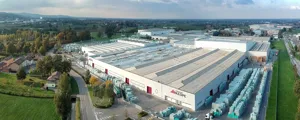Sustainability and advanced technologies
Sustainability documents such as EPDs, HPDs and CAMs highlight the commitment of companies to environmentally friendly and public health-conscious manufacturing and logistical practices. These tools not only ensure compliance with strict environmental standards but also provide transparency, enabling consumers to make informed decisions based on the sustainability of the products they purchase.
The Italian ceramics industry has demonstrated how technological innovation can be integrated into product evolution by adopting processes that meet and often surpass the most advanced regulatory requirements. Continuous investments have led to significant reductions in pollution levels, which fall well below the limits set by Best Available Techniques (BAT) and current regulations.
In terms of operational sustainability, companies have optimised the use of resources. A portion of the energy is generated on-site through cogeneration plants, and 100% of wastewater is recycled and reused in production cycles.
After examining the significance of these documents as a whole, let’s now explore some of the main tools used to evaluate and certify the environmental impact and healthiness of ceramic products.













